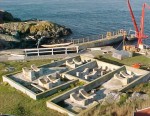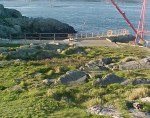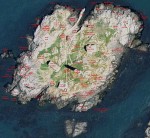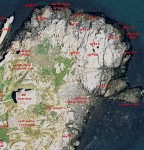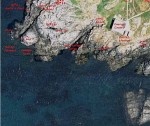BACKGROUND: Anthropogenic Modifications to our Environment.
Anthropogenic = of, relating to, or resulting from the influence of human beings on nature . So where do we fit in in terms of our own contribution to abiotic and biotic impacts in our environment? In this exercise we take a critical look at the Race Rocks Ecosystem, and actually measure and calculate one part of the Anthropogenic impact. In it you will also encounter some examples of bioremediation and restoration, some interesting history and some mysteries. Most certainly you will discover the history of how human activities can have a big abiotic impact on an island ecosystem. There are probably few places left on earth where Anthropogenic Impact has not affected the biotic and abiotic factors of the environment, and consequentially Biodiversity of species. In another assignment in the OceanQuest series on Biogeochemical Cycles, you are able to investigate this happening on a global scale. Here on Race Rocks, for centuries we have been consumers of the biotic components. First Nations people used the resources as an important part of their food supply and culture, and today we use the island for a number of reasons related to conservation, education, research and marine safety and navigation, otherwise, some of the Ecosystem Services which is the topic of another assignment in this series.
OBJECTIVES: After doing this assignment,students will be able to:
- a. Discuss anthropogenic impact as an abiotic and biotic factor in the environment.
- b. Show examples of how anthropogenic impact can have negative effects on ecological systems.
- c. Evaluate the examples of how we have tried to mitigate ( or try to reduce or make up for) the anthropogenic impact of using the island.
- d. Use a program to measure surface area to quantify the amount of anthropogenic disturbance to the Race Rocks ecosystem.
e. Use a program which allows you to calculate the surface area affected in your own ecosystem.
PROCEDURE:1. In the pictures below, you see an example of how human actvities can have a large physical impact on the amount of area previously “removed” from the ecosystem. On Race Rocks, it has been happening since the 1860 when the light station was first installed. Fortunately however the story does not end there. In this file we document the story of restoration of this and other sites on the island over the past few years.It shows how we can try to lessen our impact if we make a decision to do so. How significant a process is ecological restoration in reducing human Anthropogenic Impact? https://www.racerocks.ca/oil-tank-farm-restoration/
- Before restoration in 1999
- After restoration in 2002
2. In this part of the assignment, we are going to see some of the trade-offs we have had to make in order to obtain the ecosystem services of Race Rocks. Using the aerial image map of the island below, devise an exercise that allows you to calculate the Anthropogenic footprint on the island. Literally, what percentage of the island is removed from habitat and ecological productivity by the effects of the human activities. To calculate areas or distances, you can go to the CRD Natural Areas Atlas. Find Race Rocks at the South end of Vancouver Island and use the measurement tools as needed.
- Complete Island image
- Detail of northwest corner
- Detail of northeast service
- Detail of Southwest corner
- Detail of Southeast corner
3. The Anthropogenic impact on the ecosystem in which you reside can be measured using this technique. If you are able to get an aerial image, all you need is a known measurable unit that is visible to calibrate distance in order to calculate the percentage of the area taken up by human built feature.
4. Extension: The Anthropogenic impact of a city can also be measured using this technique. You may look for a city on the google earth maps, all you need is a measured unit to calibrate your distance in order to calculate the percentage of the areas taken up by human habitation and industry.
This assignment on Biogeochemical cycles also makes reference to Anthropogenic Impacts:
This assignment on Abiotic Factors is relevant to the concept of Anthropogenic change

